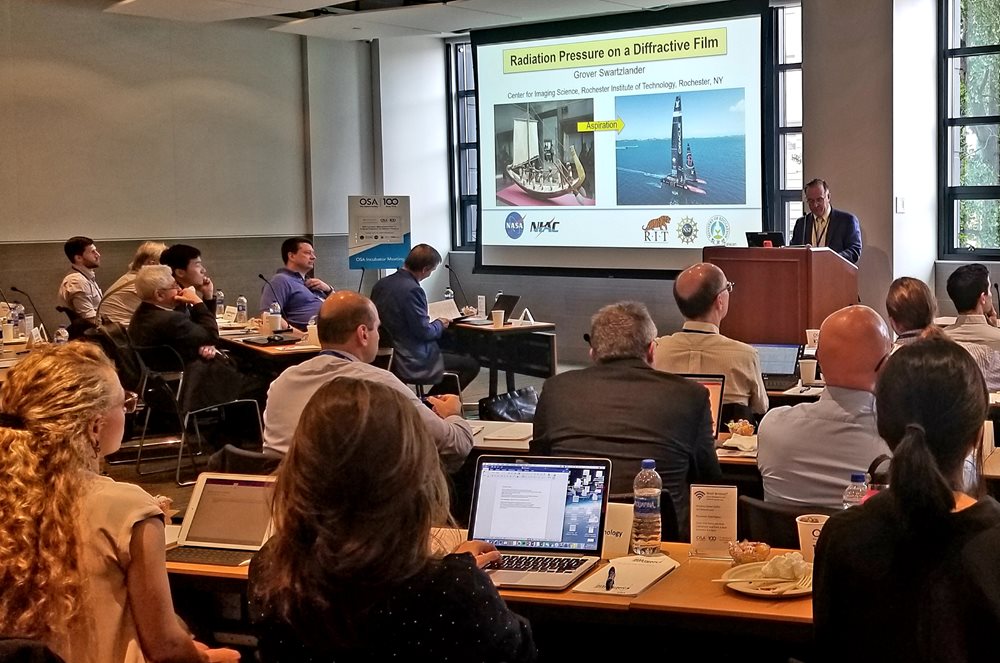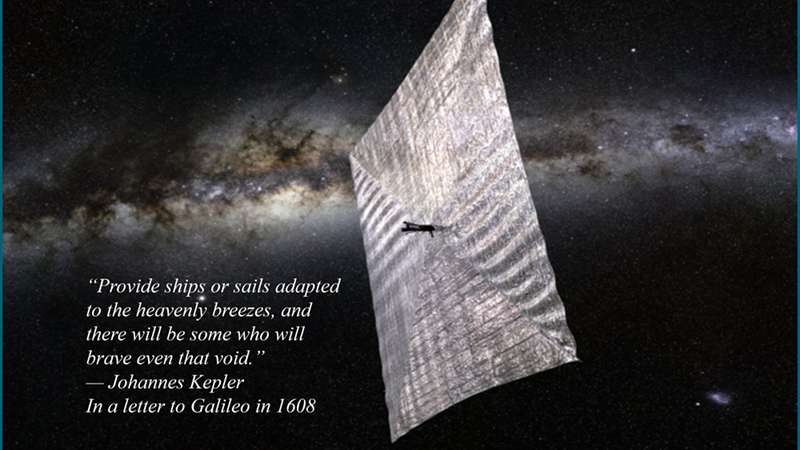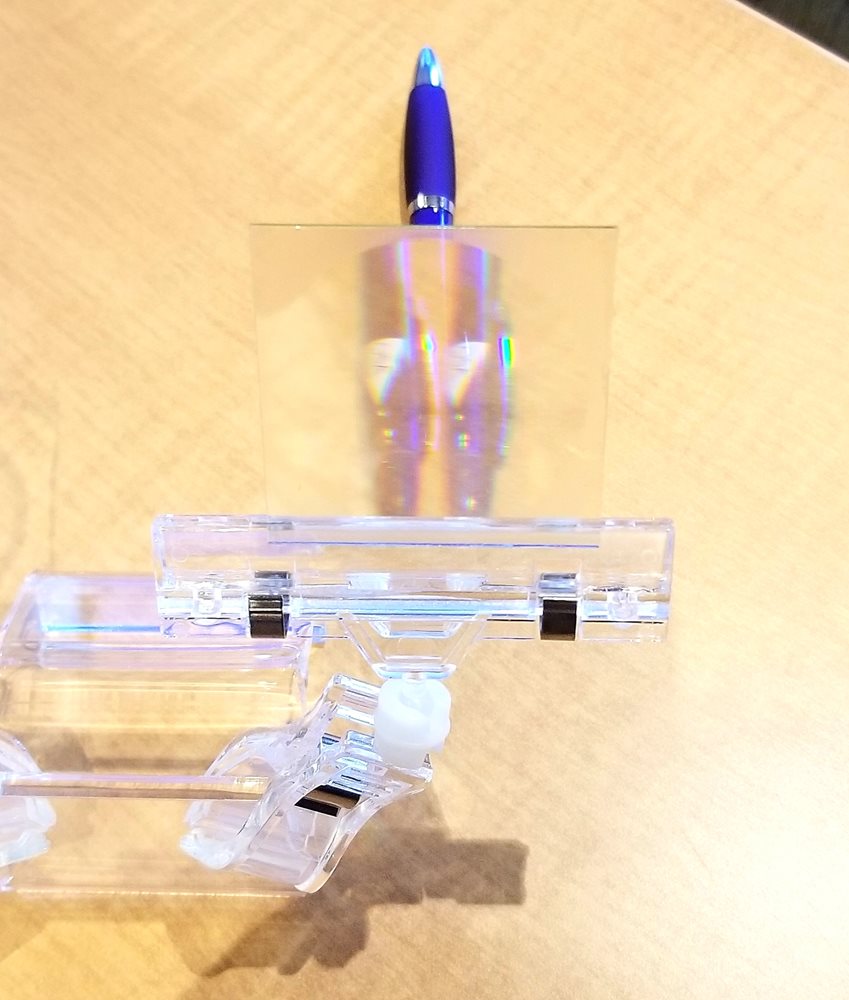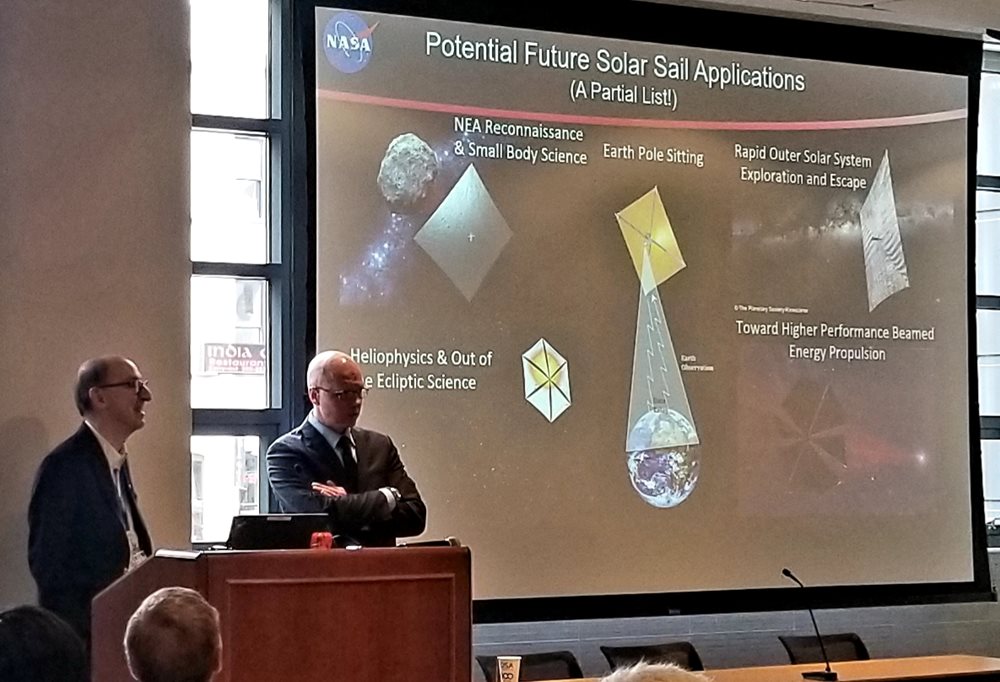Day 1 of the Metamaterial Films for In-Space Propulsion by Radiation Pressure Incubator
Day 1 of the Metamaterial Films for In-Space Propulsion by Radiation Pressure Incubator
Amber Dubill, RIT

The Optical Society’s CEO, Liz Rogan started off the conference by reminding everyone that this week is the 60th anniversary of NASA, a fitting coincidence for the conference. Optics and photonics has and continues to enable our understanding of the universe, the center goal of this OSA Incubator (Metamaterial Films for In-Space Propulsion by Radiation Pressure). Dr. Grover Swartzlander, RIT, (right) one of the hosts, called this Incubator a chance to bring three diverse groups together: aerospace, optical, and materials scientists. The goal of the incubator is to create a roadmap for using diffractive metamaterials in solar sailing. This will be accomplished by documenting of ideas from the three participating groups as well as building enthusiasm in the communities for solar sailing applications.
The idea of solar sailing is to use the change of momentum of light as a propulsive force. The use of metamaterials can optimize the use of this force. Solar sails are advantageous over conventional propulsion methods because they use a massless and abundant propellant: light. This is not without challenges.
 (Photo courtesy of Bruce Betts, The Planetary Society.)
(Photo courtesy of Bruce Betts, The Planetary Society.)Dr. Swartzlander, Bruce Betts, The Planetary Society, and other experts called to attention the issues with the current state of solar sailing technology. Large sail areas are needed with very small masses, which in turn produces very thin sails. The packaging, deployment, ability to withstand the harsh space environment, and attitude control of these thin material sails is yet to be perfected. The dependency of mass and area of the sail is a challenging engineering requirement for these sail-craft and missions towards the sun deal with extreme temperature environments. They challenged the three communities to discuss solutions to these issues.
Solutions to these issues were proposed using current technology. Switchable gratings and reflectivity devices were seen as an important technology that could enable less complex methods of attitude control of large sails. The state of transparent conductors was discussed in in the context of minimizing mass on the sails and minimizing the chance of sail boom buckling. In space, assembly of these sails may bypass the problems with sail deployment and packaging. Thermally, sail materials are being manufactured that can survive within 0.5 AU, but more advancement in the thermal properties of these metamaterials is needed for closer approaches.
The current state of diffractive optics and metamaterials was discussed by co-host Nelson Tabiryan, BeamCO. Metamaterials are used to produce very high efficiency gratings with very thin films. Diffractive waveplate optics are smooth and continuous, with thin coatings that could be very applicable to diffractive solar sails. The gratings needed for diffractive sailing need to have broadband capabilities and high efficiency across a range of wavelengths. These high efficiency gratings can be designed to be mission specific. Electrically switchable optics are already being developed. The metamaterial community is developing gratings and materials that could survive harsh space environments. Optimization techniques could be used to develop the best sail material for the mission requirements. These materials have tradeoffs thermally and structurally for their use as optical surfaces. In addition to these desired properties, the materials must also be thin and lightweight. In response to the role of advancing technology for solar sailing applications Valdmir Shalaev, Purdue University, responded “We are not talking about new physics, diffractive physics is well known - we are talking about new material challenges, manufacturing challenges.”
Laser driven sails were discussed as a subsection of solar sailing capabilities. For further out future missions, laser driven sails may be a way to enable interstellar travel. Harry Atwater, California Institute of Technology, stated “If you want to develop a space craft to travel near the speed of light, then the only viable propellant is light itself”. Breakthrough Starshot was discussed, a proposed laser driven sail that will get to 20% the speed of light to get to the nearest promising exoplanets within a lifetime. This consists of a 1 m^2 sail driven from a 100 GW laser array based on Earth. Discussions from this Incubator may find solutions for some of the challenges with this mission architecture.
Solar sails could enable more efficient deep-space missions that would gather useful information to further our understanding of the universe. Co-host Les Johnson, NASA and Nathan Barnes, L’Garde, discussed some of these desired missions. Near-Earth-Asteroid Reconnaissance and Small Body Science missions, Helio-physics and Out of the Ecliptic Science missions, Earth Pole Sitting, Rapid Outer Solar System Exploration and Escape missions, and missions Toward Higher Performance Beamed Energy Propulsions could all be enabled by solar sailing technology. Specifically, Earth Pole Sitting is a highly-desired opportunity for both the scientific community and industry for space weather stations at an artificially made L1 point. These solar sailing-based missions are not as mainstream because of risk aversion. The ideas from this Incubator could reduce the risk from these missions.
The program continues this afternoon with breakout sessions that will explore inner solar system, outer solar system, and laser-light driven missions so stay tuned tomorrow for additional updates and a look at what’s next for these efforts.
 Incubator host Nelson Tabiryan, BeamCo, demonstrated a diffractive optic lens with an OSA pen.
Incubator host Nelson Tabiryan, BeamCo, demonstrated a diffractive optic lens with an OSA pen. Host Les Johnson, NASA and Nathan Barnes, L'Garde, discuss the Sailcraft Mission.
Host Les Johnson, NASA and Nathan Barnes, L'Garde, discuss the Sailcraft Mission.
